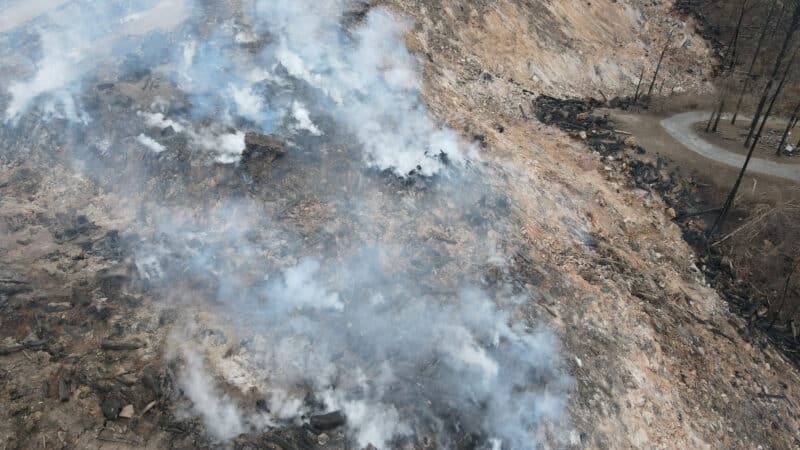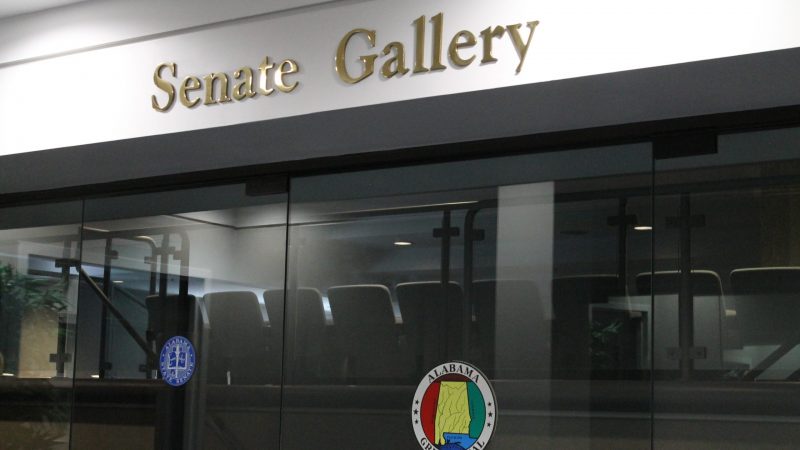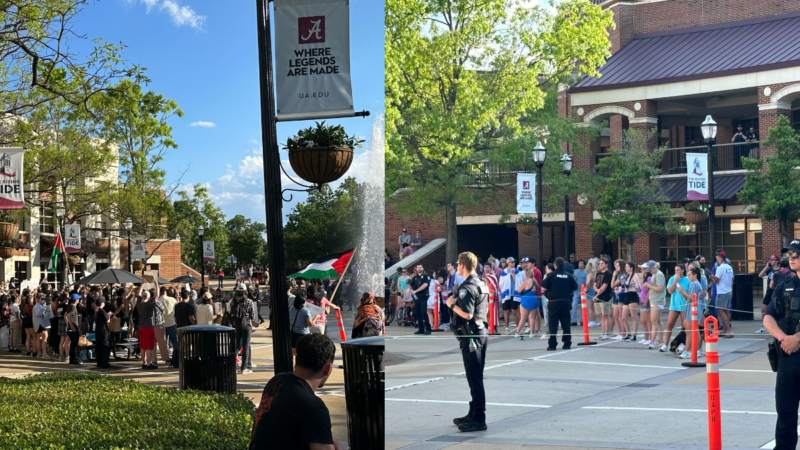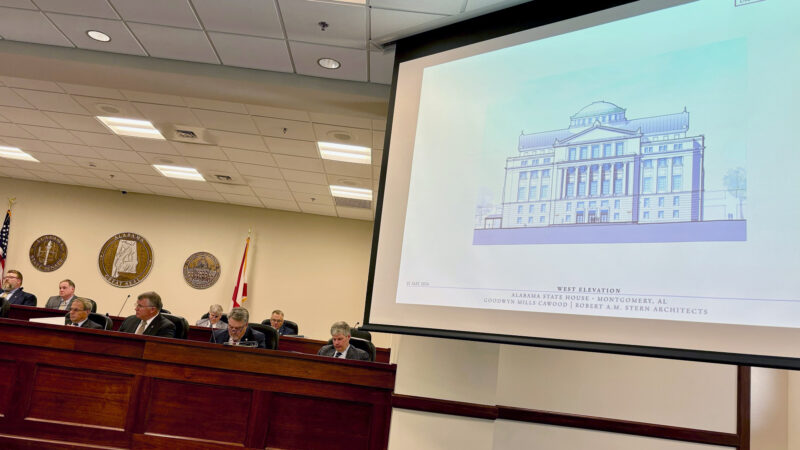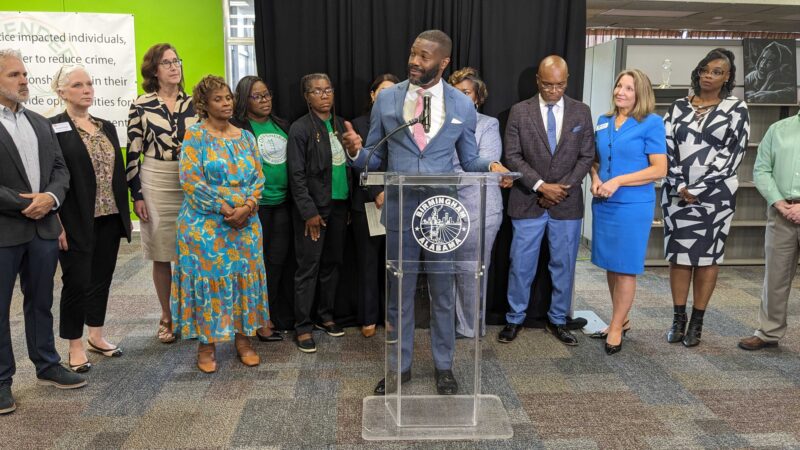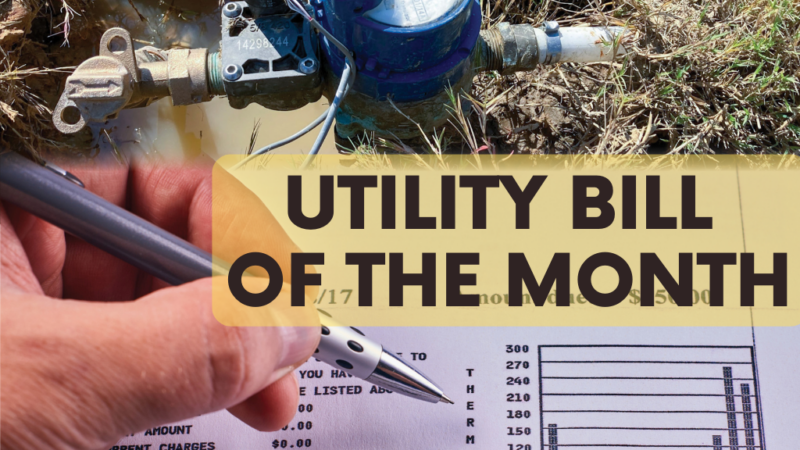Will the Moody Landfill Fire Ever Be Extinguished? The EPA Isn’t So Sure.
An arial photo shows smoke billowing from an underground fire at the Environmental Landfill, Inc. Property in December 2022.
This article originally appeared on Inside Climate News, a nonprofit, independent news organization that covers climate, energy and the environment. It is republished with permission. Sign up for their newsletter here.
By Lee Hedgepeth, Inside Climate News
MOODY, Ala.—Richard Harp couldn’t believe his ears.
On Thursday, he heard for the first time from Inside Climate News that an EPA official had publicly confirmed what he already knew—the massive underground landfill fire near Moody, Alabama, just a football field away from his home, is still burning. In fact, the official told ICN, it may never be extinguished.
Harp was shocked by the admission. He and his family moved from their Moody home to a rental in Irondale, Alabama, after open flames consumed dozens of acres, leaving residents to deal with the impacts of the resulting smoke. But Harp, a minister and former firefighter, said that he’s been concerned about the EPA and some media outlets’ characterization of the fire, which he felt had suggested it had been extinguished.
On Thursday, following up on residents’ concerns about a continued underground fire at the site, Inside Climate News contacted EPA officials with a simple question: Is the landfill fire near Moody, Alabama, still burning either above or below ground?
In a resulting interview, James Pinkney, section chief of public and governmental affairs for EPA Region 4, confirmed that the underground fire in Alabama continues to burn.
“With a landfill, you can never really extinguish the fire. All we can do is respond,” Pinkney said. “And what we’re doing—the approach we took at this landfill is using soil to basically suffocate the flames. But a landfill can burn for an extended period of time underground.”
Harp said that Pinkney’s statement is the first time he’s heard an EPA official confirm that the fire continues to burn underground. He said that he has felt that state and federal regulators have done their best to underplay what’s continuing to unfold in Moody, just southeast of Birmingham. His fears were confirmed when he received a copy of a thermal image of the site that showed continued underground burning not visible to the naked eye.
The landfill blaze began at the Environmental Landfill northeast of Birmingham, near Moody, in November 2022. The landfill’s operators could not be reached for comment on Thursday. In the 15 months since it first flashed to the surface, the subterranean fire covered dozens of acres, with burning material reaching more than 150 feet deep.
The fire and resulting smoke left residents suffering from health impacts and schools limiting outside activity. All the while, state and local officials pointed fingers as to who should be responsible for dousing the flames. Only after federal officials stepped in was the fire smothered with sand.
But what came in the months following the initial EPA response has been anything but comforting, according to Harp and David Butler, staff attorney for Cahaba Riverkeeper, an environmental nonprofit that’s monitored the situation in Moody since its onset.
Butler said that the public perception of the situation has been that the fire was extinguished months ago.
“They haven’t updated their public-facing website since March of last year,” Butler said. “It is completely unacceptable. I believe their intention has been to just calm people down—to prevent them from pushing for more answers.”
Pinkney said that the EPA will continue to respond to any reports of hotspots as they’re made aware of them.
“We have a local contractor that we’ve hired if there are hotspots, or if we see smoke,” he said. “We address it at that time.”
Pinkney, a longtime Moody resident himself, said that the EPA will continue to have boots on the ground as long as necessary.
EPA’s strategy of covering the fire with soil means that as soil erosion occurs, the underground fire may be exposed to oxygen that can cause “flare ups,” Pinkney explained.
“So once we see that, we react to it immediately,” he said. “And that is why we will be here long term.”
Both Harp and Butler said that as long as there is a fire burning underground, they are concerned about the risks to public health. EPA officials should continue to collect and publish air samples from near the site, they argued.
Pinkney said that a full “suite” of air monitoring was completed sometime around June and that another sampling is underway.
“If those results come back showing any type of contaminants that are being released in an area, then, of course, we’ll have we’ll address the public,” Pinkney said. “We’ll make sure that the public understands what’s going on out there in that area to give them an opportunity to, you know, if there’s a need to evacuate or to move out of the area, they can make an informed decision. But as of right now, we haven’t received anything that would indicate that need.”
If the EPA believes no risks exist, Butler said, they should be transparent and regularly release their data to the public.
“Over the last month, they’ve been out there almost daily,” Butler said of the EPA. “And so why isn’t that reflected in that public facing website? All these people have questions about it, and they’re not giving any answers. I don’t understand it.”’
Even when covered by material like soil, underground fires can last for years because of small amounts of oxygen that provide a catalyst for any material still left in the site.
Robert Gray, a fire ecologist, told the CBC in 2019 that underground fire can become particularly persistent in dry conditions and in places where a lot of fuel is present.
“You need a combination of very deep ground fuel — that means duff and litter and roots and buried logs — and then you need drought conditions,” Gray said. “If you have that combination, then you have fires that can get into that deep, deep, dried organic material, and with just a little bit of oxygen they can hang on for years.”
While the landfill near Moody had been permitted to accept only vegetative material, concerns about other types of hazards burning underground have left residents worried about the air they’re breathing. Butler said it’s not reasonable for the EPA to conclude that there are little or no health impacts as long as there are no open flames or visible smoke at the site.
“That’s absurd,” he said. “You cannot look at air or water and understand what pollutants it’s carrying. Without ever investigating what is buried there, I don’t know how anybody could be comfortable that the fumes coming off that landfill are not dangerous.”
Butler said as long as the fire continues to burn, even underground, residents should push for answers about the impacts on the environment and on their own health.
“We believe that as long as that fire is burning that there’s a risk to everybody that is around it,” he said. “The only way to mitigate that risk is to understand what’s actually burned, and regulators have done nothing to do that.”
Pinkney is not ignorant of the impacts of the landfill fire. The EPA official said that early on, he couldn’t be at the Moody site for more than a few minutes.
“It got to the point where it was really affecting me,” he said. “So you can only imagine the people around there, how it affected them.”
Harp said he wants the fire near his home extinguished completely, not just smothered with soil. He doesn’t buy the argument that the EPA, the world’s largest environmental regulator, doesn’t have the ability to put the blaze out.
Pinkney said that other options like firefighting foam present risks because of the so-called “forever chemicals” they contain. Water, he said, isn’t a good option because of the runoff pollution it would cause.
Harp said he doesn’t buy that no other option exists, suggesting that, for example, a layer of polypropylene could be placed over the site to help prevent oxygen from reaching the smoldering embers.
“That’s a load of manure,” he said of Pinkney’s claims. “You can put a fire out. Dirt is organic, and it is porous. And it will never extinguish a fire, especially at a thickness of 150 feet. I’ve talked to a landfill engineer about it, and you can’t tell me that the head of EPA can’t talk to a landfill engineer. If they don’t know how to put it out, they need to find someone who does.”
Gambling bill in doubt with three days left in the legislative session
Alabama lawmakers are coming down to the finish line for this year’s legislative session. Many bills await passage, but perhaps the biggest one up in the air is a lottery and gambling bill.
Pro-Palestinian demonstration draws counter-protest at University of Alabama
Students gathered demanding the school call for a permanent and immediate ceasefire and to push the school to sever ties with defense contractor Lockheed Martin.
A new Statehouse and related projects will cost about $400 million
The Alabama Legislative Council, a 20-member panel comprised of legislative leaders and their appointees, approved the construction of the new Statehouse last year. The panel was given an update on the project on Wednesday.
New pilot program will offer housing, resources to people leaving prison
The Birmingham Reentry Alliance will provide wrap around services to dozens of men and women adjusting to life after prison.
Alabama committee advances ban on LGBTQ+ pride flags in classrooms
The Senate Education Policy Committee voted 5-2 for the House-passed bill, putting the proposal in line for a possible final passage in the last four days of the legislative session.
A New Orleans garden paid hundreds of dollars in fees for a sewer that doesn’t exist
Galvez Garden owner Lissie Stewart has been fighting the New Orleans Sewerage and Water Board over inaccurate billing for years.
